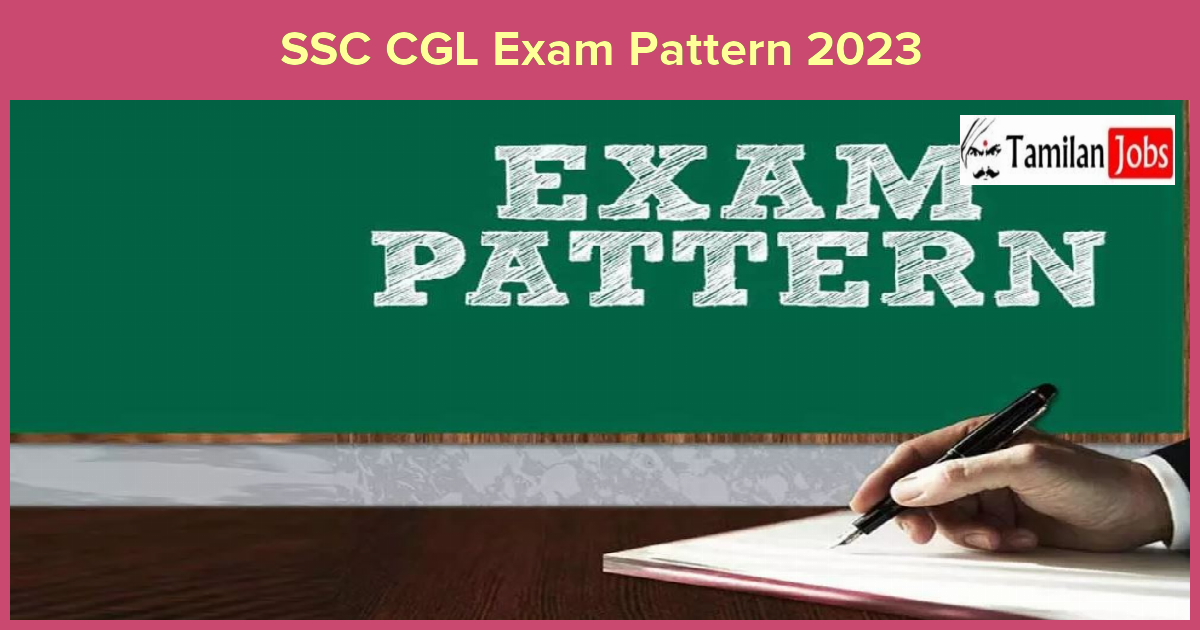SSC CGL Exam 2023: The Staff Selection Commission (SSC) conducts the Combined Graduate Level (CGL) exam in two stages: Tier I and Tier II. This exam is known for providing job opportunities for various Group ‘B’ and Group ‘C’ posts in different Ministries/ Departments/ Organizations of the Government of India and various Constitutional Bodies/ Statutory Bodies/ Tribunals, etc. In this article, we will provide you with all the necessary information about the SSC CGL exam pattern, marking scheme, and more.

SSC CGL Exam 2023 – Overview
| SSC CGL 2023 Exam Pattern – Details | |
|---|---|
| Organization Name | Staff Selection Commission |
| Department | Group ‘B’ and Group ‘C’ |
| Post Name |
|
| SSC CGL Selection Process | Tier I & Tier II |
| Vacancy | 7500 (tentative) |
| Category | Exam Pattern |
| Exam Mode | Computer-Based Test (Online) |
| Question Type |
|
SSC CGL Exam Pattern 2023
The SSC CGL exam pattern comprises two stages: Tier I and Tier II.
Tier I Exam Pattern
- The Tier I exam is mandatory for all aspirants and is qualifying in nature.
- It comprises 4 sections with 100 objective-type, multiple-choice questions for 200 marks.
- The questions will be available in both English & Hindi except for English Comprehension.
- There will be a negative marking of 0.50 for each wrong answer.
- The four sections in the Tier I exam are General Intelligence and Reasoning, General Awareness, Quantitative Aptitude, and English Comprehension.
Tier II Exam Pattern
- The Tier II exam comprises three papers i.e paper I, II, and III.
- Paper I is mandatory for all posts. Paper II will be for only those candidates who apply for the Junior Statistical Officer (JSO) and Statistical Investigator Grade-II posts. Paper III will be for only those candidates who apply for Assistant Audit Officer/ Assistant Accounts Officer post.
- Tier-II (all papers) shall consist of objective type, multiple choice questions, except for module-II of section-III of paper-I.
- The questions shall be bilingual (English & Hindi) except for English Language and Comprehension module in section II of paper-I.
- Negative marking of 1 mark for each wrong answer shall be applicable in section-I, section II, and module-I of section III of paper-I and 0.50 marks for each wrong answer in paper-II and paper-III.
- It will be mandatory for the candidates to qualify all the sections of Paper-I.
SSC CGL Marking Scheme
- The Tier I exam is qualifying in nature and only the marks obtained in the Tier II exam shall be considered for final selection.
- The final SSC CGL Merit list will be prepared on the basis of the overall performance of candidates in the Tier-II Examination only.
- The CGL Merit List for the post of Junior Statistical Officer (JSO) and Statistical Investigator Grade-II will be prepared based on the aggregate marks obtained in section-I & section-II of paper-I and paper-II of Tier-II examination subject to qualifying section-III (both modules) of paper-I of Tier-II.
- The SSC CGL Merit List for the post of Assistant Audit Officer and Assistant Accounts Officer will be prepared based on the aggregate marks obtained in section-I & section-II of paper-I and paper-III of Tier-II examination subject to qualifying section-III (both modules) of paper-I of Tier-I.
Topics Covered in Tier I Exam
1. General Intelligence and Reasoning
– Analogies
– Similarities and differences
– Spatial visualization
– Spatial orientation
– Problem-solving analysis
– Judgment
– Decision making
– Visual memory
– Discrimination
– Observation
– Relationship concepts
– Arithmetical reasoning
– Verbal and figure classification
– Arithmetical number series
– Non-verbal series
– Coding and decoding
– Statement conclusion
– Syllogistic reasoning, etc.
2. General Awareness
– Static General Knowledge (Indian History, Culture, Geography, Polity, etc.)
– Science
– Current Affairs (National and International)
3. Quantitative Aptitude
– Simplification
– Interest
– Percentage
– Ratio and Proportion
– Average
– Problems on Ages
– Speed Time and Distance
– Profit and Loss
– Number System
– Mensuration
– Data Interpretation, etc.
4. English Comprehension
– Spot the Error
– Fill in the Blanks
– Synonyms/Antonyms
– Spelling Error
– Idioms and Phrases
– One-word substitution
– Sentence Improvement
– Active/Passive Voice, etc.
Topics Covered in Tier II Exam
1. Paper I
– Arithmetic Ability
– Number Systems
– Fractions and Decimals
– Ratio and Proportion
– Percentage
– Profit and Loss
– Simple and Compound Interest
– Time and Work
– Time and Distance
– Mensuration
– Geometry
– Trigonometry
2. Paper II
– Statistics
– Collection and Representation of Data
– Measures of Central Tendency
– Measures of Dispersion
– Moments, Skewness, and Kurtosis
– Correlation and Regression
– Probability Theory
– Random Variable and Probability Distributions
– Sampling Theory
– Statistical Inference
3. Paper III
– Finance and Accounting
– Fundamental Principles and Basic Concepts of Accounting
– Financial Accounting
– Basic Concepts and Principles of Economics
– Theory of Demand and Supply
– Theory of Production and Cost
– Forms of Market and Price Determination
– Indian Economy
– Economic Reforms and Growth, etc.
Note: The SSC CGL exam is a highly competitive exam that requires a lot of hard work and dedication. It is essential to have a clear understanding of the exam pattern and marking scheme to prepare well for the exam. With the help of this article, we hope that you have gained a better understanding of the SSC CGL exam pattern and marking scheme.